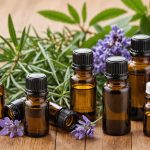Guidelines for Safely Incorporating Essential Oils at Home with Young Children
Using essential oils can be a wonderful way to create a calming and healthy environment for your family, but when it comes to young children, it’s crucial to approach their use with caution and careful consideration. Here’s a comprehensive guide to help you safely incorporate essential oils into your home with babies and children.
Understanding the Risks and Precautions
Before diving into the world of essential oils, it’s essential to understand the potential risks, especially when it comes to young children. Essential oils are highly concentrated extracts from plants, which makes them potent and potentially hazardous if not used correctly.
Also to see : Discover How Weighted Blankets Can Alleviate Anxiety and Improve Sleep Quality
“Essential oils are natural but they still are not all created equal when it comes to our pets and little ones,” notes an article from Home Made Lovely[5].
Skin and Respiratory Issues
Essential oils can cause skin irritation and allergic reactions, particularly in children who have thinner skin and less-developed immune systems. For instance, if essential oils come into contact with the skin, they may result in a rash known as contact dermatitis[2][4].
Also read : Unlocking the Advantages of a Low-Glycemic Diet for Those with Prediabetes: A Comprehensive Guide
Ingestion and Poisoning
One of the most critical risks is accidental ingestion. Essential oils can cause serious poisoning, seizures, or even death if swallowed. It is vital to keep essential oils out of reach of children and pets and to ensure they are screwed shut securely[2][4].
Interactions with Medications and Conditions
Essential oils can interact with medications or exacerbate certain health conditions. For example, some oils can affect the liver or kidneys, which could be problematic for children with pre-existing health issues. Always consult with a healthcare professional before using essential oils, especially if your child is on medication or has a medical condition[2][4].
Choosing Safe Essential Oils for Children
Not all essential oils are safe for children, and it’s important to select oils that are known to be gentle and non-irritating.
Recommended Essential Oils
Here are some essential oils that are often considered safe for children, provided they are used correctly:
- Lavender Oil: Known for its calming effects, lavender oil can be used in aromatherapy or diluted with a carrier oil for topical use. It is often recommended for teething pain and promoting sleep[3][4].
- Chamomile Oil: Chamomile is another calming oil that can be used for teething and soothing skin irritations. However, it should be used in very diluted form and with caution[3][4].
Essential Oils to Avoid
There are several essential oils that should be avoided around children due to their potential toxicity:
- Eucalyptus: Can irritate the airways and is not recommended for children[2][5].
- Peppermint: While some sources suggest it might be safe, it is generally advised to use with caution due to its potency[2][5].
- Sage: Known to be too potent for young children and can cause adverse reactions[5].
- Birch: Contains methyl salicylate, which is similar to aspirin and can be toxic if ingested or used improperly[5].
How to Use Essential Oils Safely
Using essential oils safely involves several steps to ensure they do not harm your children.
Dilution
Essential oils must be diluted with a carrier oil before being applied to the skin. Here’s a general guideline for dilution:
| Essential Oil | Carrier Oil | Dilution Ratio |
|---|---|---|
| 3 drops of essential oil | 1 teaspoon of carrier oil | 3% solution |
For example, you can mix 3 drops of lavender essential oil with 1 teaspoon of coconut or jojoba oil[3][4].
Patch Testing
Before applying any new essential oil blend to your child’s skin, perform a patch test. Apply a small amount of the diluted oil to a discreet area of the skin and wait 24 hours to see if there is any reaction[2][4].
Aromatherapy
Aromatherapy can be a safe way to use essential oils around children. Use a diffuser to spread the oil particles in the air, but ensure the room is well-ventilated and the child is not too close to the diffuser. Here are some tips for using aromatherapy safely:
- Use the Right Amount: Only use a few drops of essential oil in the diffuser to avoid overwhelming the child.
- Choose Safe Oils: Stick to oils like lavender and chamomile that are known to be calming and safe.
- Monitor the Child: Keep an eye on your child’s reaction to the aromatherapy and stop if they show any signs of discomfort or irritation[3][4].
Practical Tips for Using Essential Oils with Babies
When it comes to babies, the rules are even more stringent due to their sensitive skin and developing immune systems.
Teething Relief
For teething pain, some parents use essential oils in a very diluted form. Here are some tips:
- Dilute Heavily: Use a very low dilution ratio (less than 0.25%) and apply it to the jaw area, not directly on the gums or skin[3][4].
- Avoid Ingestion: Never put essential oils inside a baby’s mouth or on their face. Ingestion can lead to serious health issues[3][4].
Calming Blends
For creating a calming environment, aromatherapy can be very effective. Here’s a simple recipe:
- Lavender and Chamomile Blend: Mix a few drops of lavender and chamomile essential oils in a diffuser to create a soothing atmosphere.
Storage and Safety
Always store essential oils in a cool, dry place away from direct sunlight and out of reach of children. Here are some additional safety tips:
- Label and Store Properly: Ensure each bottle is clearly labeled and stored securely.
- Educate Family Members: Make sure all family members understand the risks and how to use essential oils safely[2][4].
Real-Life Examples and Anecdotes
Many parents have successfully used essential oils to help their children, but it’s crucial to learn from their experiences.
A Parent’s Experience with Lavender Oil
One parent shared their experience of using lavender oil to help their baby sleep: “I diluted a few drops of lavender oil with coconut oil and applied it to my baby’s skin before bedtime. It really helped her relax and sleep better.”
A Cautionary Tale
Another parent learned the hard way about the importance of patch testing: “I applied undiluted peppermint oil to my child’s skin, thinking it would help with a cold. However, it caused a severe rash. Now, I always do a patch test before using any new essential oil.”
Consulting Healthcare Professionals
Before starting to use essential oils, especially if you have young children, it is advisable to consult with a healthcare professional.
Why Consult a Doctor?
A doctor can help identify any potential health issues that might interact with essential oils and provide personalized advice on safe usage. Here’s what a healthcare professional might say:
“Essential oils can be beneficial, but they are not a replacement for medical care. Always consult with a doctor before using them, especially if your child has any underlying health conditions or is on medication,” advises a healthcare expert[2][4].
Incorporating essential oils into your home can be a wonderful way to promote health and well-being, but it requires careful consideration and adherence to safety guidelines, especially when it comes to young children.
By choosing the right essential oils, diluting them properly, using aromatherapy safely, and consulting healthcare professionals, you can ensure that these natural remedies benefit your family without posing any risks.
Remember, safety always comes first, and with the right knowledge and precautions, you can enjoy the many benefits that essential oils have to offer.
Recommended Dilution Ratios
Understanding dilution ratios is essential for safe usage, especially when handling potent substances like essential oils. Proper dilution minimizes the risk of adverse reactions and maximizes their benefits. Essential oils, by nature, are highly concentrated, and applying them directly can irritate the skin or cause sensitivity.
Importance of Dilution for Safety
When using essential oils, safety should always be the primary concern. Dilution ensures that the oils are used in a manner that is both effective and non-threatening. For adults, a standard dilution ratio is often 2% or approximately 12 drops of essential oil to 30ml of a carrier oil. For children and the elderly, a reduced concentration, such as 1% (6 drops per 30ml), is recommended.
Recommended Dilution Ratios by Age
Adjusting the dilution ratio according to age ensures everyone’s safety:
- Adults: 2% dilution
- Children/Elderly: 0.5% to 1% dilution
- Infants: Essential oils are generally discouraged unless advised by a professional.
Common Diluents and Their Application
Common diluents include carrier oils like coconut oil, jojoba oil, and grapeseed oil. These not only aid in dilution but also nourish the skin. For effective use, simply blend your chosen essential oil with a suitable carrier oil before topical application. This practice ensures that the essential oil’s benefits are delivered safely.











